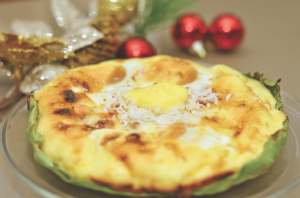A guide to Filipino X’mas dishes for those who need to know
LOS ANGELES — There is no doubt that Christmas is one of the Filipinos’ favorite holidays. Aside from having the longest holiday season (starting in September until January), Christmas is the time for parties, gift-giving and, of course, a multitude of culinary delights.
On Christmas Eve, the last Mass of Simbang Gabi is attended; and then noche buena — a family feast — takes place after midnight. Noche buena (“good night” or “holy night” in Spanish) is a Filipino custom adopted from Spain and Mexico. It is not your typical meal, as it is very much like an open house celebration where everybody who drops by is invited to partake of what is served on the table.
Food is in abundance, often served buffet style. Among the noche buena staples include favorite Filipino dishes such as lechon (roasted whole pig), pancit, barbecue, rice, adobo and native rice cakes (kakanin — biko, sapin-sapin, bibingka, puto bumbong, or cassava cake).
However, Western influence has brought in spaghetti or fruitcake, and a fusion of Filipino with international dishes.
Here are some of the noche buena spread favorites:
- Hamon/hamonado – Ham, (from the Spanish jamon). Pork marinated in pineapple juice, sugar, salt and spices; then baked.
- Keso de bola – Literally, a ball of Edam cheese (a semi-hard cheese from Netherlands), usually with a red paraffin wax covering.
- Bibingka – Flat cake cooked in banana leaves with salted egg, kesong puti, served with butter and grated coconut.
- Lechon – Roasted pig, pork belly, chicken, fish — it means anything that’s roasted over coals. But in Filipino households, it is always the lechong baboy (pig) that rules over the table.
- Leche flan – The Filipino version of a creme brulee — but better. A mixture of egg yolks, condensed milk, fresh milk and sugar; this sweet concoction is steamed and topped with caramelized sugar.
- Macaroni salad – Although every Filipino has their own version, this dish starts with the same ingredients — pasta, mayonnaise and chicken. Others add carrots, celery, cheese and sometimes pineapple.
- Spaghetti – Filipino-style, that is. Made with tomato sauce and paste, ground beef or pork, cheese and a little sugar to sweeten the taste, the spaghetti is a Filipino staple in parties and for noche buena.
There is no doubt that Filipinos love to celebrate occasions and holidays with food. However, this is grounded on the Filipino value of being family-oriented. Though the noche buena’s central focus may seem to be on the feast being served, the real reason for getting together is partaking the food over laughter, storytelling and love.








